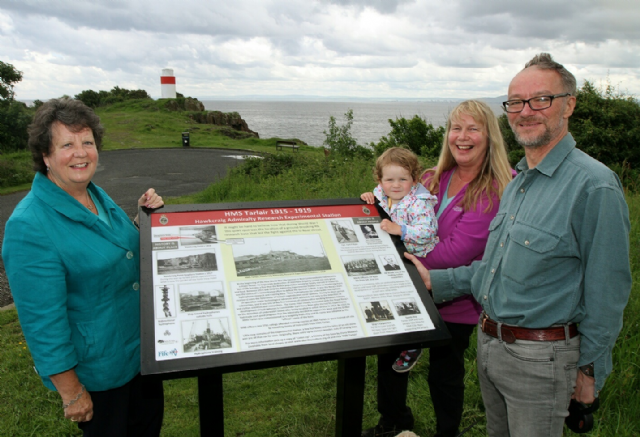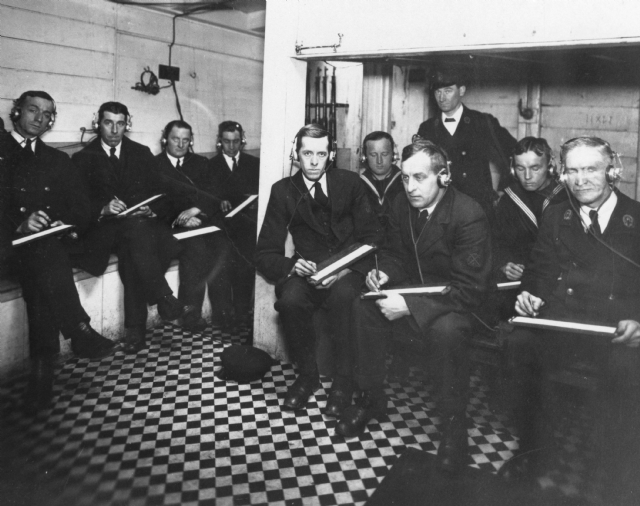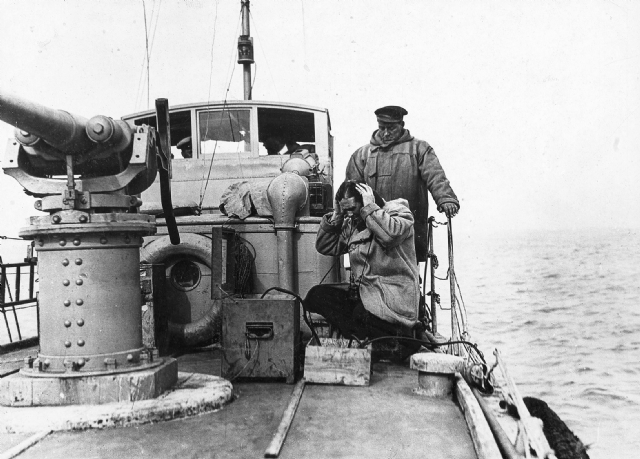Why?
During its time of operation significant technological advances were made, including:
- development of methods of submarine detection, through hydrophones, indicator loops and seaplanes,
- development of Magnetophone mines and depth-sounding bombs,
- introduction of the Photophone (similar techniques were later used to record sound on film for the first "talkies"),
- experiments into remote/wireless control, including modifying a motor launch, first so that it could be controlled remotely from land or another ship and then demonstrating independent control from a flying plane.

Who?
Diana Maxwell, who has lived in Aberdour since she was five, is a keen local historian and has written articles, published locally, on Aberdour in the first half of the 20th century.
Interpretation panel installed as part of the HMS Tarlair project at Hawkcraig Point, the site of the base. Thanks to Fife Council for their assistance and support with this.
Whilst researching this era she stumbled upon the fascinating story of the First World War Admiralty Experimental Establishment Station, HMS Tarlair, at Hawkcraig in her home village. What was more amazing was that the person in charge of the base (Captain Cyril P Ryan) had lived in her house, Hawkcraig Cottage! Diana wrote a couple of articles for the local Village News and some years later at a local history event in the village met with a group of people who together decided to further research the history of the base and its personnel, with the intention of making sure that this important story could be brought to wider attention. Various archives have been researched, local stories have been collected and an archive of material has been gathered, the result of which was the publication of 'Listen Up!' in 2014 - with a revised, expanded edition published in 2016. Exhibitions and talks have been organised to spread the word and the book is widely available.
Aberdour is a small village on the north coast of the Firth of Forth, present population approx. 1,800. Before the outbreak of WW1 it was best known as a tourist destination from Edinburgh and Glasgow. It seems remarkable that it should have been the site of a research establishment that played a significant part in Britain's war at sea and yet so little was known of the work carried out there. Imagine the impact that the base must have had on the local area and population, most of whom will never have seen a submarine or sea plane. What must they have they thought as they witnessed the trials of new technologies on their doorstep? The base played an active part in the life of the village, increasing the population significantly, as a few thousand permanent and temporary personnel passed through.

Hydrophone training class under instruction
The base was the Navy's main The base was the Navy's main hydrophone and research training base. 1,090 officers and 2,731 ratings attended courses here or were trained by instructors from Hawkcraig.
By the end of the war HMS Tarlair numbered 650 ratings and 120 officers, manning hydrophone stations at home and abroad. 31 shore hydrophone stations were set up around the coast of the British Isles and further abroad, and ships were also attached to Hawkcraig.
Tarlair staff fitted submarines with hydrophones and issued special sets of hydrophones to the 1,500 drifters and motor launches in the Auxiliary patrol.
How?
The project began with Diana's interviews with people from Aberdour who remembered the base. On hearing of her interest, local people provided further information, which enabled her to extend her research and produce articles for the local Village News. More recently, we have been actively searching for more information (much easier with the advent and expansion of the internet!) and have found relevant material in various papers and archives, including the National Submarine Museum, the Fleet Air Arm Museum, the National Maritime Museum Archive, the National Archives, the American Institute of Physics Niels Bohr Library Archive. The base is mentioned in a number of contemporary biographies and letters and we have been greatly helped by people who have heard of our interest and spontaneously provided information. A full list of the sources is included in 'Listen Up!'. For researchers in the field, we would be happy to hear from you and share what we know.
This website contains a fraction of the information and images that have been uncovered whilst researching the history of the base. There is undoubtedly more out there - if you know of it, do get in touch!

